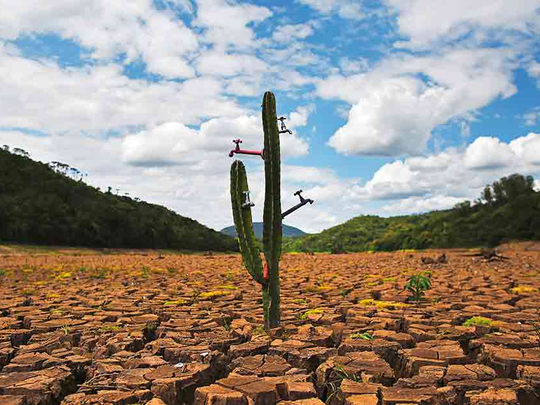
Davos 2016. During a presentation on how art can change the world, Icelandic-Danish artist Olafur Eliasson spoke about how humans, despite the perceived closeness offered by the digital world, are isolated from each other — and nature.
“We often feel untouched by global issues such as climate change, even when we could easily do something to help,” he said. “One of biggest crises the world will face is the loss of water bodies, the lakes and rivers that give us water,” he added, while launching a campaign for safe drinking water, which, over the past two years, has raised awareness and funds in several countries.
“Cities are fast running out of water, as exemplified by Cape Town’s current crisis, where the government has rationed water.”
Over the past few years, artists everywhere have been calling attention to the global water crisis.
Regional awareness
Those in the Middle East are equally responsive to these issues. Mohammad Kazem, an artist from the UAE, first showed his beautiful work Walking on Water at the Venice Biennale in 2013. Now in the Guggenheim Abu Dhabi collection, this video work is exhibited in a dark chamber that he designed, where the viewer is surrounded by images and sounds of a rough dark sea without a horizon. The constant churning of the waves can get overwhelming, and a viewer feels he or she is completely at the mercy of nature.
“I used to fish quite often, and have been rescued when I have fallen off the boat several times,” explains Kazem. “I remember that one time when I fell and it was completely dark. The people on the boat could not hear my shouts because of the sound of the engine. I could not see the horizon, and I wasn’t sure what direction I was swimming in.”
He collaborated with Igloo-Vision, a British tech firm, to create 15 projectors that have been used to show the sea in its raw form, both vertically and horizontally. “The idea was to capture themes such as loss and uncertainty.”
Elsewhere, artist Susan Shutan used painters’ tape to create a web across a warehouse wall in Kaneko, an open art space in Omaha, Nebraska, to represent the state’s major rivers threatened by industrialisation and climate change. “With the help of school students, I placed more than 700 pom-poms that represent the site we tested water for pollution. Some tests came back with pollutants at levels higher than the federal guidelines recommend, particularly two rivers cutting through the state’s agricultural heartland, which are now filled with nitrates that run off from the fertilised fields nearby.”
On a wall, the artwork may have looked pretty and whimsical, but Shutan says it represented the horror we are living with. She has since taken her work around the world. “I grew up in Michigan, surrounded by the Great Lakes, so water has figured prominently in my sculptures. I love the fluid quality that water possesses, the ability to cut through rock and soil. Water issues are global, but like politics, everything is local.”
Climate change
Several artists are also working to spotlight climate change. Brazil-based Mundano is known for creating works that call attention to the water crisis afflicting his home town, São Paulo. He also often instals his cacti artworks, created from recycled water pipes, in lakes, reservoirs and locations affected by the lack of water. “They represent, to me, how Brazilian people survive on so little, particularly so little water. Each of my sculptures is fitted with taps that run real fresh water.”
Thousands of kilometres away, in Perth, Australia, Cindy Lane recreates the fascinating sea life that we are losing to climate change in highly textured water colours. “I am attempting to capture the fragility and beauty of the underwater world,” she says. The issue is close to home for her: the Great Barrier Reef has been hit by severe bleaching over the past two years, and 35 per cent of it has been confirmed dead.
Jason Taylor, a London-based artist, approaches the water crisis by flagging up how climate change is sending sea levels soaring. The creator of the world’s first underwater museum, his latest work is The Rising Tide, which he first showed in London in 2015. The 3.3-metre-tall sculpture, horse sculptures with men astride, have the body horse and ghastly oil derricks instead of a head.
“At high tide, you see only the body of the horses and the men riding them,” says Taylor, who has since travelled to major cities such as Berlin and São Paulo with the work. “But as the tide goes down, you see the ghastly pumps emerge.”
With the world fast running out of fresh water, art can play a big role in how we approach conservation.











